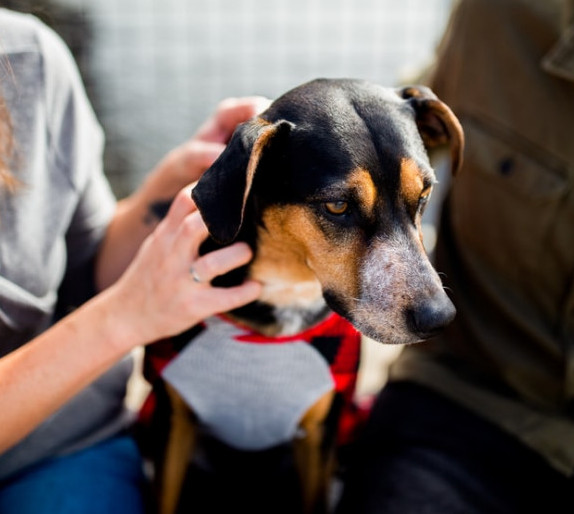How to Reduce Stress in dogs
The feelings of pressure or strain describe the word stress. There are various causes of stress. You may get stressed while doing your daily job, any disruption in your activity, or meeting with strange and new people. To help, you might go to some relaxing place where you solace yourself. Perhaps you start cleaning your house so that you can divert your attention, or visit your best friend to alleviate the pressure of work or home. 
At perfectpuppypal.com, we are not qualified veterinarians or animal nutritionists. The information that we provide is general and educational information only and is not a substitute for professional advice.
As we do, dogs also experience feelings of anxiety and stress. When humans show some signs or exhibit some feelings of stress, we may slam doors forcefully, hang up the phone arrogantly, or come out with some unusual outbursts.
All these behaviours show that we are suffering from some form of stress. But dogs and other animals can’t do such crazy things. They can’t arrogantly slam the door or hang up the phone. But, some dogs can behave violently towards other dogs and humans. Maybe they tremble or perhaps seek out strange places around the home they would not normally go to, in order to hide.
Dogs suffering from stress can show subtle behavioural changes. It is essential as dog owners to understand these changes in your four-legged friend so we know what situations they find uncomfortable and ultimately learn how to reduce stress in dogs.
Indicators that Your dog suffering from stress
There are various signs that your dog exhibits, which are clear indications that your dog is under stress. Below are some common indicators that show your dog is suffering from some form of stress.
Shaking or pacing
Your dog shakes its body when it comes out after a bath or may roll around on the ground. This scenario can be pretty ludicrous and seems funny, but this is only true if your dog is not suffering from a stressful situation. A typical example is when you take your canine companion to visit your local veterinarian. When dogs visit a vet for whatever reason, it is normally quite a stressful situation for them.
Maybe your pal shakes or trembles uncontrollably when it is on the examination table, or perhaps they pace up and down the waiting room to avoid the stressful situation as most humans do.
Barking or whining

Nearly all dogs love to bark, they do it quite often during the day and for many different reasons. It is a normal vocalization or expression to exhibit their feelings. In normal circumstances, everything is all right, it’s just dogs being dogs.
But beware when your furry friend barks for too long without any possible reason, here, he or she may be suffering from stress. Dogs that are tense or afraid may bark or whine as a way to soothe themselves or to get your attention to show you that they are in a stressful situation.
Licking, drooling and yawning
Dogs do tend to yawn a lot when they feel bored or tired but take care as they may also yawn a lot when they are under stress. The sleepy yawn that is produced when tiredness is taking hold, is not as intense and prolonged as when they encounter a stressful situation.
As with yawning, other signs that Fido could be suffering from stress are when he or she licks themselves or drools more excessively than they usually would. Although licking, drooling, and yawning are all typical behaviours of dogs, it’s important to pay attention as if any of these activities are carried out in excess then your canine companion could be under stress.
Changes with ears and eyes
When dogs get nervous and are suffering from stress then it is common for the appearance of their ears and eyes to change. Stressed dogs tend to blink rapidly and their pupils can appear dilated. They also tend to look startled, and their eyes are sometimes a little more open than usual resulting in them appearing a bit whiter than they would normally be.
With startled and overly stressed dogs, very often their ears become upright and pinned which is not frequent when they feel in a relaxed and calm state. Pinned ears also express an alert behaviour in dogs due to some unusual activity or possible danger.
Shedding
Dogs can shed their coats when they feel nervous. When paying a trip to the veterinary clinic, dogs also show excessive shedding. Also, when dogs visit somewhere that is new or different to them, for example, a new park or different walk route, they can become scared of their new surroundings, which they haven’t come into contact with before, so, as a show of their anxiety, shedding can become more frequent.
Posture changes
No one knows your dog and how they behave in different situations better than you, the loving owner. So it should be easy for you to notice a change in posture when your dog is stressed. An average dog when behaving normally, generally puts all its body weight on all four legs equally. However, when a dog is under stress, he or she tend to focus on putting all their weight onto their hind limbs only, Dogs, when they are scared of something or are feeling stressed, become relatively rigid and tend to tuck their tails between their hind legs.
Panting 
Panting is quite a normal behaviour for our canine companions. Dogs pant when they are in a hot environment, get excited or feel stressed. Dogs that are or have recently taken part in some sort of extreme physical activity also tend to pant.
If your dog is neither doing any physical activity nor spending time in a hot environment, then there is the possibility that your four-legged friend is showing you that he or she is suffering from some form of stress for whatever reason.
Excessive urination
Excess urination may be due to some other physical or mental problem, but if your furry friend is clinically fit, then it may also be a sign that they are suffering from some form of stress. When a dog is stressed or anxious, it is likely that they go to the bathroom much more frequently compared to a non-stressed dog.
It’s worth noting that when your dog meets a new canine friend, it is usual practice for them to urinate in order to mark their territory, but a loss of bowel function for no apparent reason could be a symptom that Fido is stressed.
Avoidance
All dogs have different likes and dislikes, and although they were originally pack animals, some dogs don’t like interacting with other canine friends. When put in such unwanted situations, certain dogs become stressed and anxious and try to make a hasty exit from where you are.
Also, other signs that the situation is stressful for them are turning away, feeling the need to lick their genitals or start sniffing the ground. They feel uncomfortable and don’t want to be in that spot, so they try to avoid the situation any way they can. As a caring pet owner in these situations, you should respect your best friend’s feelings and leave them alone. If forced into a stressful situation such as this then your pal may become aggressive.
Escaping or hiding

Dogs, when faced with a stressful situation have a habit of hiding, whether it’s behind a tree, their owners or any other object that is found in the immediate vicinity. Also, they may wish to escape the situation altogether and if they feel afraid and are off their leash could run away, so be aware.
When secured on their leash and no immediate escape is possible, they may poke their owners to move with them and to let them know it is time to leave. Such are the escaping characteristics of tense or anxious dogs.
Tips on how to reduce stress in dogs
You need to understand the difference between stressed behaviour from normal behaviour. You should know whether the dog licking his lips is asking for food or suffering from stress. But it takes time to understand all this in your canine companion and does not come just after adopting a dog.
Having a good relationship with your pet is essential when creating these understandings between you. Unlike humans and like other animals, dogs can’t do enough to alleviate stress. So, as a responsible dog owner, it is your utmost priority to reduce the stress in your precious four-legged friend.
Below are some quality tips for you to reduce the stress of your beloved pal
1. Encourage your dog to adopt a daily, regular exercise routine. Swimming, trips to the park, playing, and walking. All these activities help your dog reduce daily stress. It is also helpful to prolong a healthier life for your pet.
2. Give your pet different types of treats or toys as rewards for good behaviour. You should provide mental rehabilitation for your dog equally with physical exercise. Both are crucial for the healthy life of your furry friend.
3. Crate training can be a vital training tool for dogs to avoid stressful situations. Dogs feel safe in their dens, just like wolves. So, you should crate train your dog from the very first day he or she arrives in your home. Crate training also protects your best friend from accidents, anxiety, as well as loss during relocation.
4. Just like humans do yoga, Dogya has received much popularity among pet owners in recent years. It is a recreational activity to invite your friend to participate in an ancient exercise, calming them, reducing their stress levels, and ultimately increasing their longevity.
Apart from providing just a soothing aid and experience for your dog, this activity actually increases trust between you and your beloved furry friend.
5. If you realise and come to the conclusion that your dog is not feeling well or is stressed for some reason, then wrapping a  blanket, towel, or item of your clothing around them can make them feel more at ease, comfortable, and secure. This is because the item you wrap them in carries your scent on it, thus reducing their feelings of anxiety and stress.
blanket, towel, or item of your clothing around them can make them feel more at ease, comfortable, and secure. This is because the item you wrap them in carries your scent on it, thus reducing their feelings of anxiety and stress.
6. Some dogs like listening to calming music to soothe and relax them, other dogs love to listen to classical music. The music trick seems to work on a lot of dogs to help them feel relaxed and less stressed.
Many pet owners leave the TV on for their anxious canine companions when they leave the house to go to work, school, or maybe to do some shopping. Musical tones seem to settle stressed dogs while you are not at home.
7. Keep your cool, because when a dog is feeling stressed, it may impact the way you feel as well. Always remember not to go hard on them, as this will just worsen the situation and make them feel even more stressed and anxious. Similarly, it’s best not to give rewards or treats to your four-legged friend when they are suffering from a stressful situation. Dogs are clever creatures and sometimes when they are being rewarded for certain types of behaviour, they could repeat this behaviour in the future to trick you into giving more treats!
8. Also, it’s best not to introduce Fido to the other canines if he or she doesn’t want to and is feeling stressed. Moreover, never apply force in doing so as it will aggravate the situation even more. This stress could develop into a severe problem in the future.
9. Spending good quality time with your beloved pet in a warm blanket when they are feeling stressed is a great way of reducing the anxiety they are suffering from. Being in close proximity to you, the owner, is very comforting for your pal and can aid a lot during a stressful situation.
10. Always consult and speak with your vet before administering any human anti-depression medicines to your dog to combat any stress that they may be feeling. Humans and dogs are very different so giving human medicine to your favourite little pal can be extremely hazardous.
Sometimes it can be possible for a dog to take a fraction of the medicine that we as humans take in order to tackle our own stressful situations, but never do so without consultation with your vet beforehand. It is more than likely though that your vet will prescribe some medicine that has been specifically manufactured for animal use only.
To sum up
As mentioned a little earlier here in the post, the person who knows their four-legged friend the best is you, the owner. Knowing your canine companion well and how they react in certain situations is essential when identifying any abnormal behaviour which could lead to them becoming stressed.
I sincerely hope that the information here has been beneficial when learning how best to identify and reduce the stress levels in your beloved pet. Please remember that stressed dogs can suffer significant heart problems. So, avoiding the cause of stress at the source and reducing your loving companion’s potential stress level is crucial for a healthy life.
If you have ever had any experience dealing with a stressed dog and would like to tell us how things went or just anything else to add then please feel free to leave a comment below.
